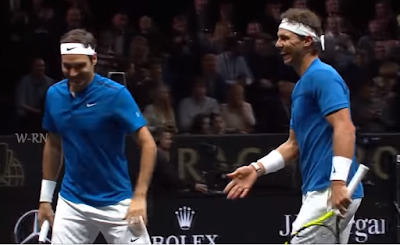Turns out that I do. What drew me in were the photos of the bonding between Fed and Rafa:
Exhibition or no, we've never seen two living legends of the game playing on the same team, and definitely not on the same side of the court. And I nearly stroked out when Nadal got in front of Fed for that overhead.
NADAL WAS NOT MESSING AROUND THIS ENTIRE WEEKEND. I know I'm not the only one who thought he was about to go off on Federer when they lost that second set. He was inTENSE.
1. Star power: I expect a lot of money was involved for Laver Cup, but alas, all that's on the line for Davis and Fed cups are national pride and, occasionally, a spot on the Olympic team. Money = playing for love of country. Just thought I'd point that out. Whatever. It's good tennis. Unfortunately, the biggest problem facing these annual tournaments is the lack of top-player interest, especially in non-tennis years. There's other ways to deal with that besides money, like adopting a Ryder Cup-styled schedule, but I'm actually getting tired of myself saying that the ITF needs to address this, so I'm gonna move on.
2. Rafa and Fed together.
My god.
3. The sliding scale scoring: I had never even thought of this, but this could be an idea that could fit Davis and Fed cups. Especially Fed Cup. I really hate that Fed Cup insists on playing its doubles last, and that you don't even get to it half the time, but what if the doubles match actually was worth more points and could sway the result? Or ... what if you followed the Davis Cup lead and moved the doubles to the middle of the rotation? Too much to ask, probably. But anyway, in the Laver Cup format, this worked great for suspense. It all hinged on the very last match, which was a great match! I'm sure one day, Nick Kyrgios will beat Federer, but I fear it will be in Jim Courier's old-man league.
4. Timing: In two ways -- the shortened format and at the end of the Grand Slam season. I feel like exo events can do whatever they want, and this isn't the place for five-setters with no tiebreaks. To its credit, this event was set up for optimal efficiency. They won't even play it in a place without a roof, per the rules.
Obviously, it's a great idea not to shove this right in the middle of the calendar. But also, Laver Cup couldn't have come at a better time as far as current events. While half the country was arguing about the railings of an unacceptable president and the ensuing illogical ramblings of people equating standing up for a song and saluting a flag to loyalty to a country (and yeah, I have thoughts), I found refuge on Sunday in watching some great tennis.
So, thanks, fellas. On several levels.




No comments:
Post a Comment